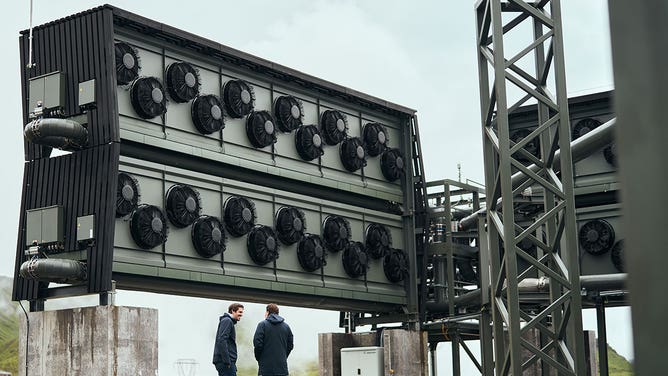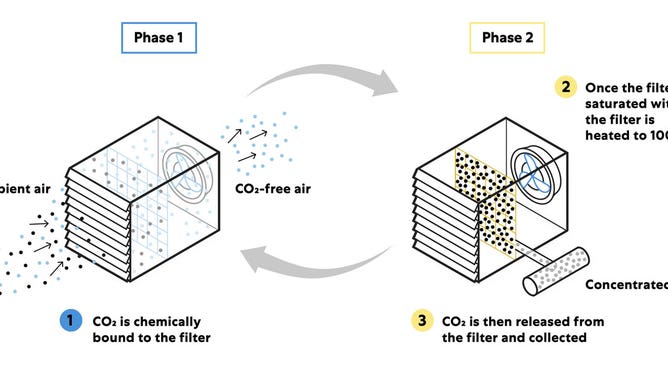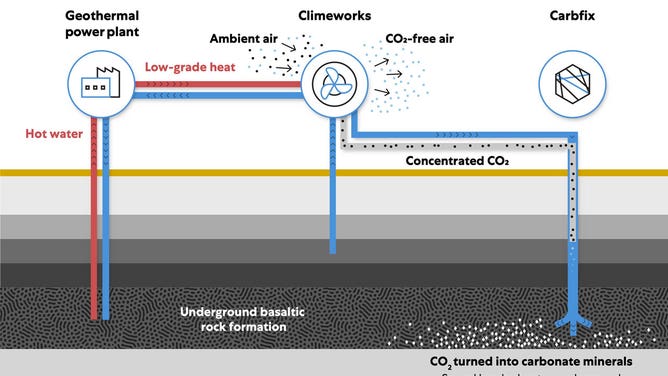‘We’re boxing in the Last Chance Saloon’: How one company aims to take on climate change
Climeworks’ new plant in Iceland scrubs greenhouse gas CO2 directly out of the air

Climeworks' Orca carbon-removal plant in Hellisheidi, Iceland.
(Climeworks)
Several container-sized boxes packed with fans in a remote part of Iceland are at the forefront of humanity’s fight to reverse climate change.
In early September, Switzerland-based Climeworks opened a plant in Hellisheidi called Orca aimed at collecting the greenhouse gas carbon dioxide directly out of the air and permanently storing it underground. It’s being billed as the world’s largest direct-air capture and storage plant.
"I know this sounds borderline crazy, but imagine it's, I don't know, 1850. We are in London and I'm proposing to you, 'Hey! Let's build a sewage system for the city,'" said Christoph Beuttler, head of climate policy at Climeworks. "That must have felt roughly the same, and this is essentially what it is. It's a waste management problem. It's just a very big one."
How it works
Orca is comprised of eight boxes mounted several feet off the ground. One side of each box is packed with 12 fans aimed at pulling air into highly selective CO2 filters and then spew the purified air back into the atmosphere.
"Once we have saturated the filter, we have to make the CO2 unstick from the filter material, and the technology we have can dissolve at around the boiling point of water – so, 100 degrees Celsius," Beuttler said. "Why is that important? Because that enables us to use either renewable electricity or waste heat, and we don't have to burn fossil fuels to run the plant."

This infographic shows how carbon dioxide is pulled from the air and then scrubbed from the filters at the Orca plant.
(Climeworks)
Once it’s unstuck, the CO2 is combined with water and shunted underground where it undergoes a mineralization process created by Climeworks’ partner Carbfix.
According to Carbfix, the carbonated water combines with specific types of rock to begin a chemical reaction. That reaction forces the carbon to solidify within a couple of years, permanently storing the removed CO2 as underground rock.
Beuttler said there are no long-term implications of storing the removed carbon in this fashion.
"It’s also a naturally occurring process that happens, but it usually takes tens of thousands of years," Beuttler said. "Carbfix has just sped it up to two years."

This infographic explains how the Climeworks Orca plant works.
(Climeworks)
Beuttler said the entire removal and storage process is powered by a nearby geothermal power plant, which eliminates the use of power generated from burning fossil fuels.
Just the beginning
According to the National Oceanic and Atmospheric Administration, between 35 million and 40 million tons of CO2 are emitted into the atmosphere each year. The Orca plant can capture about 4,000 tons annually – a drop in the bucket, compared to the size of the challenge.
Beuttler said the Orca plant is just the first step in this process and that scaling the technology up to filter even more air is vital.
"We have the resources to do it. It's just whether we get the will to start this early."
According to Beuttler, the Orca plant cost about $10 million to build. However, he said, costs should come down as the technology is further developed.
"We need three planets worth of trees to solve the problem."
Orca is between 90% and 95% efficient, according to Beuttler.
"That means, net, they only emit 5-10% of gray emissions over the whole cradle to grave life cycle," Beuttler said. "That means from building them to running them to eventually recycling them."
Beuttler said he expects those emission levels to come down even more in future iterations of the technology.
Climeworks hopes to open more carbon-scrubbing plants over the next several years, Beuttler said.
Beuttler said Climeworks is looking closely at locations in the U.S. where their carbon-removal process would be doable. He said one of those places is the Permian Basin in Texas and New Mexico – one of the biggest petroleum fields in the world.
Why this and not trees?
Trees -- all plants for that matter -- are nature’s way of purifying the air. They suck up carbon dioxide from the air and combine it with water during the photosynthesis process, which provides them with food. Oxygen is expelled as a byproduct.
So, why not just plant more trees to fix our CO2 problem? According to Beuttler, there’s not enough space for all the trees we would need.
"We need three planets worth of trees to solve the problem," Beuttler said.
Working together
Beuttler said that Climeworks’ approach to climate change – removing excess CO2 directly from the air – is just one of many approaches aimed at the problem.
Other emission controls, such as capturing greenhouse gases at smokestacks, are also aimed at reducing the amount of carbon dioxide that is put into the atmosphere.
Beuttler said that while removing those gases at the source is a worthwhile endeavor, the excess CO2 remains in the atmosphere.
"So carbon dioxide removal and carbon capture are two very different things," Beuttler said. "Both will be needed, but they need different policy mechanisms."
Beuttler said a reduction in society’s dependence on fossil fuels, the burning of which produces greenhouse gasses, is also a necessary step in reducing the amount of carbon dioxide in the atmosphere.
‘Last Chance Saloon’
As Beuttler sees it, climate change is one of the biggest threats to humanity’s survival.
"This is not about the environment or nature or saving some species," Beuttler said. "It's about saving our species, at least at the numbers we are currently."
United Nations Secretary-General António Guterres would seem to agree. He called a recent climate report published by the organization’s climate change panel a "code red for humanity." The report called on the world to act fast to limit carbon emissions.
Beuttler said governments of the world have been talking about the problem for 40 years while emitting more and more greenhouse gasses. It’s time for action, he said.
"We’re boxing in the last chance saloon, so to speak," Beuttler said. "This is really it."






